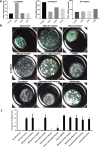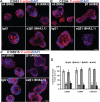Cellular polarity modulates drug resistance in primary colorectal cancers via orientation of the multidrug resistance protein ABCB1
- PMID: 30306567
- PMCID: PMC6519031
- DOI: 10.1002/path.5179
Cellular polarity modulates drug resistance in primary colorectal cancers via orientation of the multidrug resistance protein ABCB1
Abstract
Colonic epithelial cells are highly polarised with a lumen-facing apical membrane, termed the brush border, and a basal membrane in contact with the underlying extracellular matrix (ECM). This polarity is often maintained in cancer tissue in the form of neoplastic glands and has prognostic value. We compared the cellular polarity of several ex vivo spheroid colonic cancer cultures with their parental tumours and found that those grown as non-attached colonies exhibited apical brush border proteins on their outer cellular membranes. Transfer of these cultures to an ECM, such as collagen, re-established the centralised apical polarity observed in vivo. The multidrug resistance protein ABCB1 also became aberrantly polarised to outer colony membranes in suspension cultures, unlike cultures grown in collagen, where it was polarised to central lumens. This polarity switch was dependent on the presence of serum or selected serum components, including epidermal growth factor (EGF), transforming growth factor-β1 (TGF-β1) and insulin-like growth factor-1 (IGF-1). The apical/basal orientation of primary cancer colon cultures cultured in collagen/serum was modulated by α2β1 integrin signalling. The polarisation of ABCB1 in colonies significantly altered drug uptake and sensitivity, as the outward polarisation of ABCB1 in suspension colonies effluxed substrates more effectively than ECM-grown colonies with ABCB1 polarised to central lumens. Thus, serum-free suspension colonies were more resistant to a variety of anti-cancer drugs than ECM-grown colonies. In conclusion, the local stroma, or absence thereof, can have profound effects on the sensitivity of colorectal cultures to drugs that are ABCB1 substrates. © 2018 The Authors. The Journal of Pathology published by John Wiley & Sons Ltd on behalf of Pathological Society of Great Britain and Ireland.
Keywords: ABCB1; colon; drug resistance; polarity; primary culture; spheroid.
© 2018 The Authors. The Journal of Pathology published by John Wiley & Sons Ltd on behalf of Pathological Society of Great Britain and Ireland.
Figures






Similar articles
-
Aberrant activation of Rho/ROCK signaling in impaired polarity switching of colorectal micropapillary carcinoma.J Pathol. 2021 Sep;255(1):84-94. doi: 10.1002/path.5748. Epub 2021 Jul 16. J Pathol. 2021. PMID: 34156098
-
Dynamic Change of Polarity in Primary Cultured Spheroids of Human Colorectal Adenocarcinoma and Its Role in Metastasis.Am J Pathol. 2016 Apr;186(4):899-911. doi: 10.1016/j.ajpath.2015.12.011. Epub 2016 Feb 12. Am J Pathol. 2016. PMID: 26878211
-
A liquid culture cancer spheroid model reveals low PI3K/Akt pathway activity and low adhesiveness to the extracellular matrix.FEBS J. 2021 Oct;288(19):5650-5667. doi: 10.1111/febs.15867. Epub 2021 May 2. FEBS J. 2021. PMID: 33837641
-
ABCB1-dependent collateral sensitivity of multidrug-resistant colorectal cancer cells to the survivin inhibitor MX106-4C.Drug Resist Updat. 2024 Mar;73:101065. doi: 10.1016/j.drup.2024.101065. Epub 2024 Feb 6. Drug Resist Updat. 2024. PMID: 38367548
-
Mechanisms of apical-basal axis orientation and epithelial lumen positioning.Trends Cell Biol. 2015 Aug;25(8):476-85. doi: 10.1016/j.tcb.2015.04.002. Epub 2015 May 1. Trends Cell Biol. 2015. PMID: 25941134 Review.
Cited by
-
Inverted apicobasal polarity in health and disease.J Cell Sci. 2024 Mar 1;137(5):jcs261659. doi: 10.1242/jcs.261659. Epub 2024 Mar 11. J Cell Sci. 2024. PMID: 38465512 Free PMC article. Review.
-
Cancer stem cells in colorectal cancer and the association with chemotherapy resistance.Med Oncol. 2021 Mar 18;38(4):43. doi: 10.1007/s12032-021-01488-9. Med Oncol. 2021. PMID: 33738588 Review.
-
Functional Interplay Between Collagen Network and Cell Behavior Within Tumor Microenvironment in Colorectal Cancer.Front Oncol. 2020 Apr 30;10:527. doi: 10.3389/fonc.2020.00527. eCollection 2020. Front Oncol. 2020. PMID: 32426274 Free PMC article. Review.
-
Cell polarity changes in cancer initiation and progression.J Cell Biol. 2024 Jan 1;223(1):e202308069. doi: 10.1083/jcb.202308069. Epub 2023 Dec 13. J Cell Biol. 2024. PMID: 38091012 Free PMC article. Review.
-
Cancer stem cells: advances in knowledge and implications for cancer therapy.Signal Transduct Target Ther. 2024 Jul 5;9(1):170. doi: 10.1038/s41392-024-01851-y. Signal Transduct Target Ther. 2024. PMID: 38965243 Free PMC article. Review.
References
-
- Furuta S, Bissell MJ. Pathways involved in formation of mammary organoid architecture have keys to understanding drug resistance and to discovery of druggable targets. Cold Spring Harb Symp Quant Biol 2016; 81: 207–217. - PubMed
-
- Manninen A. Epithelial polarity – generating and integrating signals from the ECM with integrins. Exp Cell Res 2015; 334: 337–349. - PubMed
Publication types
MeSH terms
Substances
Grants and funding
LinkOut - more resources
Full Text Sources
Other Literature Sources
Medical
Miscellaneous

